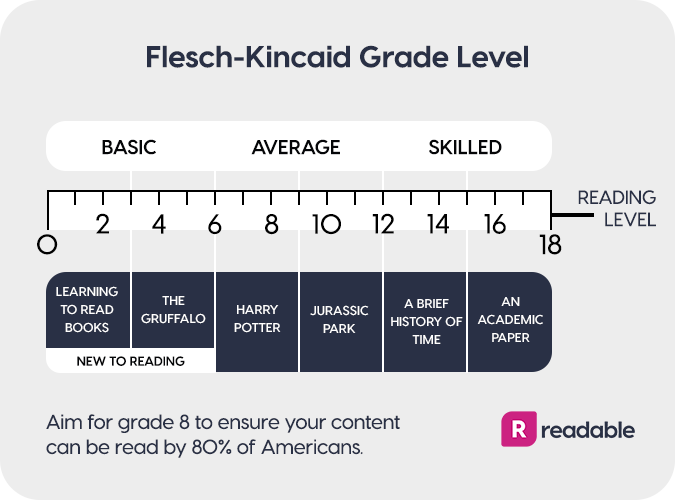Google uses over 200 ranking factors in their algorithm. Though some of them seem controversial and others are mere speculation, readability definitely isn’t.
WHAT IS READABILITY?
In short, readability is the level of ease it takes to understand written text. Good readability means that the target audience doesn’t stumble upon unfamiliar words and long sentences. They also don’t spend more time than expected trying to comprehend the overall meaning of the text. There is no doubt that Google measures the readability of a page; it even used to provide a reading level search filter and stats.

Source: Backlinko
But what does it all mean and how can you improve the readability of a text?
HOW DOES READABILITY WORK?
Not so long ago, keyword stuffing was one of the most common SEO practices. Writers had to include as many keywords as possible to make their texts more SEO-appealing. No one seemed to bother that the texts became hard to understand—or maybe they bothered, but the perks of keyword stuffing were too big to resist. Nowadays, everything is different. A text’s readability might not be specified as a direct ranking factor—at least Google doesn’t make this information public. However, it still affects your SEO.
How does it work? As you know, your ranking is defined by many factors, some of which are directly connected to readability. If the text looks good and is not stuffed with keywords, people are more likely to click on it when they see it in search results. Furthermore, they are more likely to read the text until its end, spending more time on your website as a result.
All these things signal to Google that your content is valuable, therefore increasing your website’s ranking. But, of course, not only ranking matters—good readability could benefit conversion rate as well. After all, when a text is easy to read, it could turn more visitors into actual customers. By offering information that is useful, well-structured, and easy to understand, you increase customer loyalty and build better relationships with them. And a human connection to your audience is just as essential and useful for sales as SEO.

HOW IS READABILITY MEASURED?
There are different ways to measure readability, from using Flesch-Kincaid readability tests to various plugins. Most of them usually measure the readability by the audience’s education level. People with higher education can often read more complex texts. According to Readable.io, the general recommended grade for marketing texts in the US is 8. If you write on this level, your content can be read by 80% of Americans.

Source: readable.io
SIMPLE OR NOT?
But is simpler always better? Not for all audiences. In industries like entertainment, simpler and generally lighter texts are more appreciated. However, if you’re running a professional business blog, making the texts as simple as possible can turn your audience away and lead to them questioning your authority.
Some bloggers advise writing texts that are two education levels below your audience’s. This could be a good option in some cases, but all these tips are dependent on the particular scenario. You should always view each situation individually, taking the target audience and industry into account. In any case, don’t sacrifice the quality of your content just because you think it’ll increase its readability.
WHAT ELSE CAN YOU DO TO INCREASE READABILITY?
Despite the individual nature of each text, there are still some general readability tips to keep in mind, no matter your audience or niche. Here’s what to focus on if you want to increase the readability of your texts.
1: STRUCTURE
A speech can be messy and lack structure. A text, however, cannot. It’s crucial to organise your posts logically, presenting the most essential and fundamental information first and then moving to the details. When writing, always ask yourself whether the audience will be able to follow your arguments and your overall message or not. This could help you make your text instantly better and more organised.

2: PARAGRAPHS AND SENTENCES
Even if you don’t plan on excluding industry-specific terms and details from your texts, you can still make the texts simpler. The key is in shortening the paragraphs and sentences. This is also a key part of a text’s organisation. When the sentences and paragraphs are shorter, it is easier for an audience of any level to comprehend. This also makes the text look simpler (even if it’s not as simple as it seems).
3: STYLE
Of course, every content writer has their style. But even in this case, it’s possible to improve the readability of a text without the need to change this style or to copy someone else’s. No matter how serious the topic is, you can always write more conversationally. This helps in establishing a better connection with the audience and makes a text naturally simpler. Try writing like you speak and see what difference it makes.
4: IMAGES
Images are always good for a text as people are instantly drawn to them and comprehend them quickly. Furthermore, images can make a text look simpler as well if you use them in the following way:

Source: SEOPressor
When you use images like that, readers don’t feel intimidated by texts, especially long ones. Of course, when picking images, you need to choose ones that are directly related to the content of the post, otherwise they’ll just confuse your audience.
5: FONT AND FORMATTING
Some are fine with reading small, complex-looking fonts, but most people are not. You can pick original fonts for headings and subheadings, but the body text should be in fonts that are easy to read on a screen—standard sans-serif ones. The recommended font size is 16 pixels, but you can experiment if you want. Just make sure that your audience doesn’t have to lean forward to read the text.
Also, make sure that your line height is at least 150% of the font size: If the font is 16 pixels, the line height should be 24 pixels. As for formatting, everything is simple: You need to use headings and subheadings in the text (their size should be different). Similar information should be structured into lists with numbers or bullet points. You can also use bold and italics to emphasise something in the text, but it’s entirely up to you.
The same goes for quotes—some websites make quote inserts that stand out from the rest of the formatting, but it also depends on your preferences. One of the most important and perhaps frustrating things to remember is that your ranking won’t rise immediately after you start improving your readability. But it will pay off as time goes on; so do your best, don’t give up, and work on the quality of your texts.


